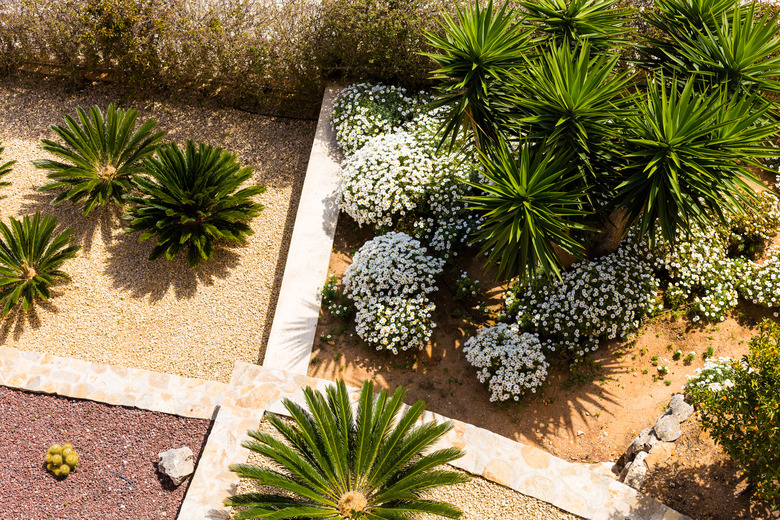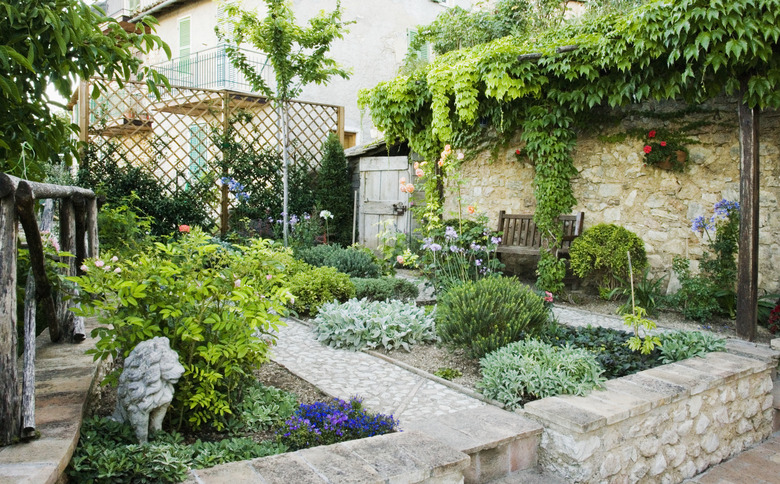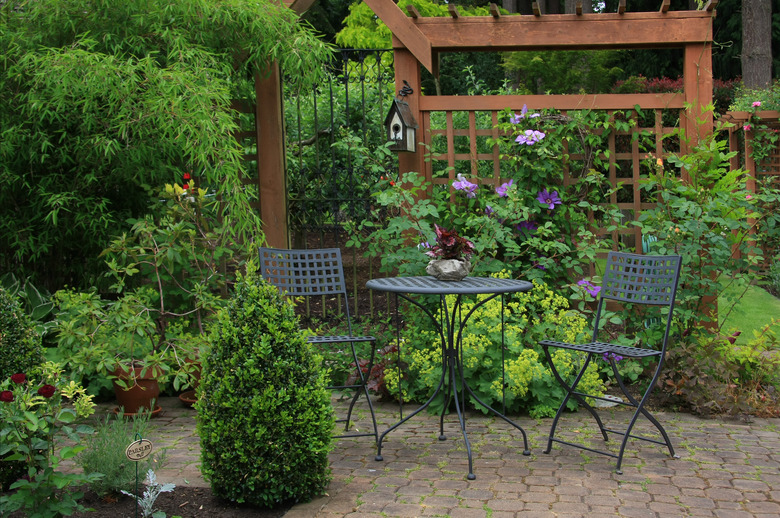Gardening Basics For Beginners
We may receive a commission on purchases made from links.
The gardening basics you need to know to start a new flower or vegetable garden could be summed up in three words: sun, soil and water. The amount of sun available for the plants depends on the location of the garden within the confines of your property and in your growing zone. The characteristics of your native soil will influence your choice of plants, but poor soil is hardly ever a deal breaker because there are many ways to amend and recondition it if you want to grow something it doesn't currently support. Finally, if you don't get enough water from the sky, you need to plan ahead to ensure plants get the water they need with minimum effort on your part. Gardening won't be much fun if you have to lug 5-gallon pails of water up a steep hill every day to keep your garden watered.
The gardening experience is almost effortless when you get everything right: choosing plants suitable for your climate zone, combining them in beneficial ways, fertilizing the soil to provide them with the nutrients they need and controlling unwanted growth and interlopers. When you get it right — and that's not hard to do, although it may take a little practice — growth takes care of itself, and the rewards can't help but be satisfying. It's no wonder so many people have adopted gardening as a hobby, a trade or a profession.
Gardening Basics: Follow the Sun
Gardening Basics: Follow the Sun
Plants can't survive without sun because they get their energy from photosynthesis, which needs sunlight to occur. A few species have learned to love full shade, especially if they grow in hot climates, but if this is your first garden, they probably aren't the ones you'll want to grow.
Balance sun and shade: If you want to maximize your possibilities and make your gardening experience a fruitful one, locate your garden so that at least part of it gets full sun for six hours a day and part gets partial sun for four to six hours a day. That way, you'll be able to grow sun-seekers, like peppers (Capsicum spp.) and tomatoes (Lycopersicon esculentum, zones 10-11), along with shade-lovers, like root veggies and garden peas (Pisum sativum). A successful garden plan puts each plant in its area of preferred sun exposure.
Know your growing zone: No matter where you live, you won't be able to grow everything. The United States Department of Agriculture (USDA) identifies 13 hardiness zones stretching from Alaska to Puerto Rico, with higher zone numbers signifying warmer conditions and a longer growing season, and the plants you can grow are those hardy in your zone. Frost dates are determined by zone, and gardeners in colder zones often lengthen the growing season by starting plants indoors and then transplanting them outdoors after the last frost.
Gardening Basics: Dig In
Gardening Basics: Dig In
Soil can be loose and sandy, claylike or somewhere in between, and you can get a good idea about the soil in your new garden by dropping some in a clear glass container, adding water and a little dish soap, shaking it and letting the contents settle. Sand will settle to the bottom, clay will stay on top and the middle layer will be composed of silt, which is the fine organic matter that makes soil "loamy." Measure the width of each layer, add the measurements and divide the width of each layer by the total to get a percentage. This simple soil identification test tells you what kind of garden soil you have and what plants you'll find easiest to grow, but it isn't the only test you should conduct.
Test for nutrients: You can purchase a kit that tests for the three main soil nutrients — nitrogen (N), phosphorous (P) and potassium (K) — as well as the pH of the soil, which is a measure of acidity. You can also collect a soil sample and have it tested in a lab or at your local cooperative extension service. This test tells you the best products to use when fertilizing. Most soil has some deficiencies, and the most complete way to round it out is to turn organic matter into the soil, such as compost or aged manure, but if you choose to use synthetic fertilizers, you'll need one with an N-P-K ratio that corrects the soil deficiencies.
Get rid of weeds: Weeding can turn your gardening experience into a chore, especially if you have to do it often. If you're starting a new garden on a plot already occupied by weeds, be sure to completely eradicate them before planting, or the young plants will have to compete for nutrients. If the plot is large enough to make pulling out the weeds by the roots impractical, consider killing the weeds by laying sheets of cardboard on the ground, covering it with topsoil and planting in the topsoil. This is known as lasagna gardening, and it's more effective than simply turning the soil, which just digs weeds in deeper and encourages them to grow again.
Be sure to add plenty of topsoil on top of the cardboard to support plant roots, and be aware that if you lay the the cardboard around established shrubs and trees, until it decomposes, the cardboard will form a barrier that disallows water to reach the roots of these trees and shrubs. So only cover small areas with cardboard, and don't snug it up around shrub and tree trunks; leave an open space around the trunks for water to penetrate.
Gardening Basics: Let It Flow
Gardening Basics: Let It Flow
No garden will grow without water, and you'll need plenty of it, especially directly after seeding or transplanting. Most mature plants need a minimum of 1 inch of water per week, and you can't always count on rain to provide that. Make sure you include an easily accessible water source in your garden plan, even if it's just a 100-foot garden hose connected to a spigot on the side of your house.
Formulate an irrigation strategy: Many gardeners cherish the moments of contemplation that handwatering makes possible, but others are too busy for daily watering and prefer to set up automatic irrigation with a timer. If you choose to install a sprinkler or drip system, the best time to do it is before planting.
Think about drainage: Few flowers or vegetables will be happy sitting in a pool of standing water. If your garden has low-lying areas where water tends to collect, dig trenches or install French drains to divert that water elsewhere. If you don't want the labor and cost that accompany digging and installing water diverters, plant rain gardens in low-lying areas where water tends to collect after rain events. Choose plants that can handle the excess water, such as the native (and aptly named) swamp hibiscus (Hibiscus coccineus, USDA zones 5-9). Conversely, if part of the garden is on steep terrain, consider terracing the slope to slow down water flow and give the soil time to absorb it.
Tips to Improve Your Gardening Experience
Tips to Improve Your Gardening Experience
A complete garden usually includes a combination of annuals, which last a single season and have to be replanted every year, and perennials, which last for two or more seasons and usually go dormant in the winter. You can group annuals together, but you can also plant them near perennials provided that the spacing is sufficient to allow them to grow. Each plant has its own spacing requirements, which you'll find listed on the seed packet, and some plants need lots of space, such as annual squash (Cucurbita spp.), although you can reduce the spacing requirements by training some plants to grow vertically.
Consider adding native plants and wildflowers to your garden. They generally require less water than plants imported from other climates, and they benefit the environment by attracting pollinators, such as bees, which will assist in the propagation of the other vegetables and flowers you plant. It's also a good idea to plant a few pest-repellent plants, such as marigolds, (Tagetes spp.), hardy chrysanthemums (Chrysanthemum x morifolium, zones 5-9), and mint (Mentha spp.), to minimize the need to use pesticides to keep insects under control.
Mulching young transplants and emerging seedlings with organic matter is a good practice that serves three purposes. Mulch helps keep the roots warm in the early spring, when the air still has a chill in it, and later in the season, when things dry out, it helps retain moisture in the soil. Finally, if you use a high-quality, nitrogen-rich material obtained by composting leaves, grass clippings and other yard waste, you might reduce the need for fertilizing or eliminate it altogether.


